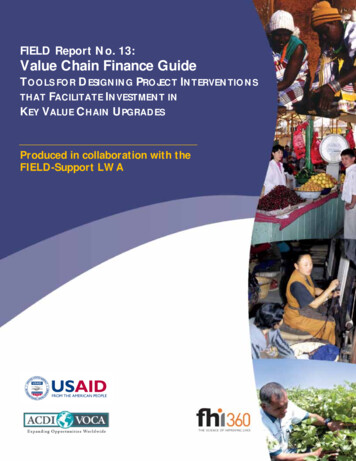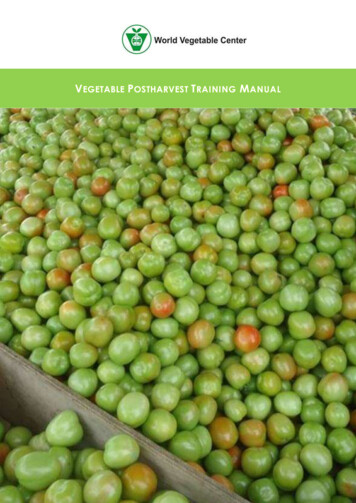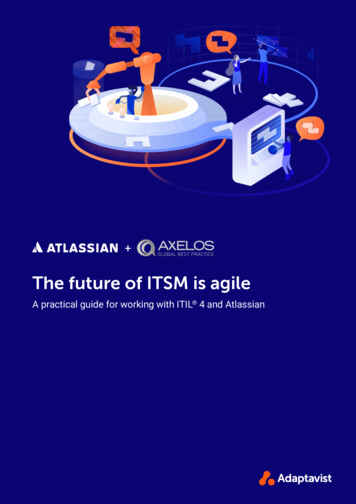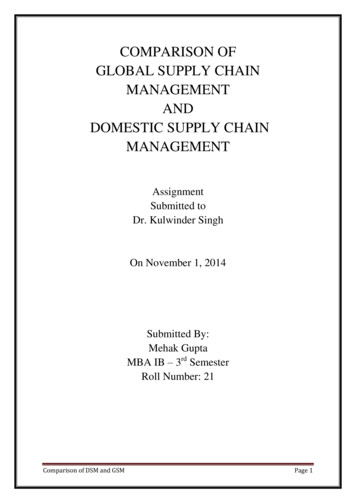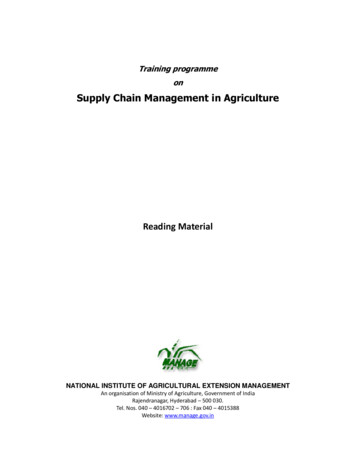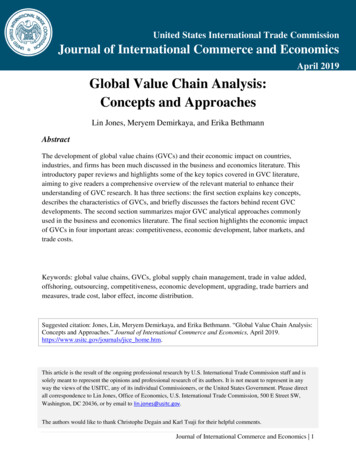
Transcription
United States International Trade CommissionJournal of International Commerce and EconomicsApril 2019Global Value Chain Analysis:Concepts and ApproachesLin Jones, Meryem Demirkaya, and Erika BethmannAbstractThe development of global value chains (GVCs) and their economic impact on countries,industries, and firms has been much discussed in the business and economics literature. Thisintroductory paper reviews and highlights some of the key topics covered in GVC literature,aiming to give readers a comprehensive overview of the relevant material to enhance theirunderstanding of GVC research. It has three sections: the first section explains key concepts,describes the characteristics of GVCs, and briefly discusses the factors behind recent GVCdevelopments. The second section summarizes major GVC analytical approaches commonlyused in the business and economics literature. The final section highlights the economic impactof GVCs in four important areas: competitiveness, economic development, labor markets, andtrade costs.Keywords: global value chains, GVCs, global supply chain management, trade in value added,offshoring, outsourcing, competitiveness, economic development, upgrading, trade barriers andmeasures, trade cost, labor effect, income distribution.Suggested citation: Jones, Lin, Meryem Demirkaya, and Erika Bethmann. “Global Value Chain Analysis:Concepts and Approaches.” Journal of International Commerce and Economics, April 2019.https://www.usitc.gov/journals/jice home.htm.This article is the result of the ongoing professional research by U.S. International Trade Commission staff and issolely meant to represent the opinions and professional research of its authors. It is not meant to represent in anyway the views of the USITC, any of its individual Commissioners, or the United States Government. Please directall correspondence to Lin Jones, Office of Economics, U.S. International Trade Commission, 500 E Street SW,Washington, DC 20436, or by email to lin.jones@usitc.gov.The authors would like to thank Christophe Degain and Karl Tsuji for their helpful comments.Journal of International Commerce and Economics 1
Global Value Chain Analysis: Concepts and ApproachesIntroductionWorld economies are becoming more deeply integrated and interdependent, with globalproduction networks and value chains (GVCs)1 among the major drivers of structural economicchanges at the global, regional, national, industry, and firm levels (Sturgeon and Memedovic2011). Leveraging advancement in transport and communication technologies, large multinationalenterprises (MNEs) incorporate offshoring and outsourcing2 as key parts of their global strategies;together with the increase in foreign direct investment (FDI) and intrafirm international trade. Boththe development of GVCs and their economic impact on countries, industries or firms have beenwidely discussed in business and economics literature, using various analytical approaches. Thispaper reviews and summarizes some of the major papers, aiming to give readers an overview ofrelevant material to facilitate their understanding of GVC research.The paper consists of three sections. The first section explains key concepts in GVC literature andbriefly discusses the factors behind GVC development over the past three decades. The secondsection summarizes three major analytical approaches commonly used in business and economicGVC literatures. The final section highlights the economic impact of GVCs in four importantareas: competitiveness, economic development, labor markets, and trade costs.Concepts and BackgroundMichael Porter first presented the concept of value chains in his influential 1985 book, CompetitiveAdvantage: Creating and Sustaining Superior Performance. Porter identifies a value chain as a setof activities that a firm performs to deliver a valuable product or service to the market. A valuechain can be broken down into five primary activities: Inbound logistics: such as receiving raw materials, warehousing, and managinginventory; Operations: all activities in the process of converting raw materials into a finishedproduct or services; Outbound logistics: such as delivering the final product or service to the end user; Marketing and sales: all strategies and activities aimed at incentivizing potentialcustomers to purchase the final product or services, including distribution channelselection, advertising, and pricing; Post-sale services: all activities that intend to improve consumer experiences, such ascustomer services, repairs, or maintenance services.1See appendix A for a list of acronyms appearing throughout this article.Offshoring refers to a firm’s arranging for work to be done in a different country, but by the same firm.Outsourcing refers to a firm contracting work out to an external organization. Offshoring can include outsourcingwhen the contractors are located in foreign countries.2Journal of International Commerce and Economics 2
Global Value Chain Analysis: Concepts and ApproachesA value chain could also include secondary or support activities that facilitate the efficiency of theprimary activities, such as procurement, technology research, product development, humanresource management, and firm infrastructure building.Porter notes that these activities form a firm’s value chain, each creating and adding value at everystage toward the end product or service. He suggests that a firm must understand its own valuechain to develop and sustain a competitive advantage (Porter 1985).Supply chain is another commonly used term. Early discussions on supply chains were morelogistics-oriented. Since the mid-1990s, however global manufacturing networks have becomeincreasingly integrated and interdependent. As a result, supply chains have been increasinglyassociated with business functions and processes beyond logistics within and across companies.3The Council of Supply Chain Management Professions (CSCMP)4 defines a supply chain as thelinks between companies which interchange materials and information in the logistics process,stretching from acquiring unprocessed raw materials to delivering finished goods to end users(Vitasek 2013). These links generally encompass three functions: (1) supply of materials to amanufacturer; (2) the manufacturing process; and (3) the distribution of finished goods to finalcustomers through a network of distributors and retailers.5 Similarly, Stacy Fredrick (2010 and2014) defines supply chains as production-related input-output links, which she illustrates withinthe value chain ecosystem using her value-chain reference model (VCRM) diagram (box 1).The concept of global value chains (GVCs) or global supply chains (GSCs) is the internationalextension of these definitions, responding to the growing phenomenon of global productionfragmentation—the fact that business functionalities and production activities along a value chainare increasingly carried out by various entities located in different countries. As a result, GVCrelated international transactions have become an important aspect of cross-border trade, andGVCs have been recognized as an important driver of structural change in the world economy(Sturgeon and Memedovic 2011).Decreasing trade costs are among the major factors that have contributed to the recent GVCexpansion. Trade costs include the whole range of costs that companies face to move goods orservices from where they are produced to final consumers (OECD 2012). Global tradeliberalization in the past few decades has significantly reduced costs associated with tariffs andsome nontariff trade barriers. Regulatory reforms in transport and infrastructure sectorsencouraged investment in roads and ports in many countries, improving logistical efficiencies.3Recognizing the new dynamics and extended content in supply chains, Council of Logistics Management changedits name to the Council of Supply Chain Management Professionals (CSCMP) in 2005. Robinson (2015).4Formerly the Supply Chain Council.5Canadian Supply Chain Sector Council, “Supply chain definitions,” urnal of International Commerce and Economics 3
Global Value Chain Analysis: Concepts and ApproachesBox 1. The value-chain reference model (VCRM) diagramIntroduced by Stacy Frederick (2010 and 2014), the value-chain reference model (VCRM) provides acomprehensive picture of value chain ecosystem. It consists of four parts: value-adding activities, thesupply chain, end-use markets, and the business supporting environment.Source: Fredrick (2010 and 2014).Value-adding activities include the six broad steps that may be required to bring a product or servicefrom a concept to end users. These activities include research and development, design, production,logistics, marketing, and services.The supply chain describes the input-output process with four basic stages—raw inputs, componentsand parts, final products, and distribution and sales—which make up production-related links in thevalue chain. These stages can be linked to the International Standard Industry Classification system(ISIC) or the North American Industrial Classification System (NAICS), and can be used to map theparticipants in the value chain. These input-output relations may differ substantially for differentindustries or products.End-use markets include consumer retail markets, public-use markets, and industrial markets. Eachmarket consists of many different products, but serves different purchasing purposes, whether forprivate household consumption, public and institutional expenditure, or business capital investment.Supporting business environments can be separated into six broad categories: infrastructure andfinance; government services; business, information, and technology services; education, testing, andtraining; trade and professional associations; and nongovernmental organizations (NGOs) andstandards. Together they provide the basic structure for all economic activities, and can facilitate orhinder the movement of products along the value chain (Fredrick 2014).Journal of International Commerce and Economics 4
Global Value Chain Analysis: Concepts and ApproachesThe emergence of mega-scale ocean-going vessels and the adoption of standardized containersexpanded shipping capacities and reduced average international shipping costs (UNESCAP report2194). Advancement in information telecommunication technology, such as the Internet, enableda new breed of logistics, distribution, finance, and business services providers, which facilitatedthe efficient configuration of GSCs and made the real-time management of GVC activities bothfeasible and inexpensive.Corresponding to this more favorable trading environment were increases in offshoring andoutsourcing activities, the use of imported intermediate inputs, and trade in intermediate goods.Three hypotheses attempt to explain these phenomena (Kleinert 2003): “The outsourcing hypothesis argues that companies in industrialized countries respondstrategically to increasing import competition from low-wage countries by relocatinglabor-intensive stages of their production process to foreign countries with abundant laborand lower wages.” (Feenstra and Hanson 1996). The multinational enterprise (MNE) network hypothesis argues that increasingintermediate goods trade is due to the rising intrafirm trade within the trading networks ofMNEs, occurring between MNEs’ affiliates in foreign and home countries as well as withparent companies (Anderson and Fredriksson 2000). The global sourcing hypothesis argues that the increasing use of imported inputs isfacilitated by international integration, whose factors, such as migration, proximity, formercolonial ties, and common language, help achieve the best match between buyers andsellers (Rauch 1999).While these hypotheses provide evidence for and arguments about motivations and enablingfactors for the development of GVCs, it is rather the fundamental change in production processesthat underlies the recent development of international outsourcing and trade. The traditional notionof production for foreign trade is horizontal, meaning that firms or countries are specialized inproducing particular final goods or services from scratch within the firm or country and exportingthem. Today, the notion of production is more akin to a highly complex network structure in whichcomponents and parts are produced at multiple stages across different countries that are linkedhorizontally, vertically, and diagonally (Henderson et al. 2002). Firms or countries are specializedin some but not all stages of the production process (Hummels, Rapport, and Yi 1998).Journal of International Commerce and Economics 5
Global Value Chain Analysis: Concepts and ApproachesSuch intra-product specialization is possible only when various tasks of a production process arephysically separable and tradable, enabled by technological change (Grossman and RossiHansberg 2006). Productivity gains, economies of scale, and potential savings in learning costsencourage the creation of firms focusing on component production. International fragmentation ofproduction processes is a precondition for outsourcing and offshoring, and it creates a verticalintra-industry international trade of components and unfinished products, with a good share of thistrade generated within MNEs (Andreff 2009).Baldwin and Venables (2013) identify twodifferentconfigurationscommonlyexisting in global production sharing:“spiders” and “snakes” (figure 1). The“spider” refers to multiple limbs (parts)coming together to form a body(assembly), being either the final productitself, or a component. The “snake” refersto the goods moving in a sequence fromupstream to downstream, with value addedat each stage. Most production networksare complex mixtures of the two, or a socalled “sniker.” These configurationsaffect production locations as well asinteractions between firms. The changes intrade frictions could have differentoutcomes for these two types ofconfigurations (Escaith 2017).Figure 1. An illustration of the “Snake, Spider,and Sniker” production configurationsSource: Escaith (2017).Journal of International Commerce and Economics 6
Global Value Chain Analysis: Concepts and ApproachesMajor Global Value Chain Analytical ApproachesBased on the business and economics literature reviewed, GVC analytical approaches can begrouped into the following four major categories (table 1). Each approach is discussed in furtherdetail in the subsections below.Table 1. Major global value chain (GVC) analytical approachesAnalyticalapproachSupply chainmanagementIndustry orproduct casestudiesInput-outputbased analyticalapproachesOther analyticalapproachesDescriptionA business analytical framework from the firm’sperspective on how a firm can enhancecompetitiveness in the context of GVCs.In-depth GVC analysis from the industry’sperspective, such as value distribution along asupply chain, key players, the main characteristicsof the value chain, etc.Quantitative analysis from a macro perspective, byapplying the input-output framework to measure acountry’s specialization in global productionnetworks and its GVC participation.Applications of general and partial equilibriummodels, as well as gravity models, for GVCrelated analysis.Measurement methodaSpecific business/industryexpertiseMicro-level firm survey;brefined Broad EconomicCategories by end useclassificationc to trade statistics.dTrade in value-added (TiVA)measurement based on intercountry input-output tables.Industry or firm data; tradestatistics; inter-country inputoutput tables, etc.aDaudin, Rifflart, and Schweisguth (2011).Hanson, Mataloni, and Slaughter (2005).c The Broad Economic Categories (BEC) is a 3-digit classification by U.N. Statistics Division that groups goods according totheir main end use. The 4th revision includes seven top categories: food and beverage; industry supplied not elsewhere specified;fuel and lubricants; capital goods, parts and accessories; transport equipment, parts and accessories; consumer goods notelsewhere specified; goods not elsewhere specified. It is linked to the basic classes of goods in the System of National Accountswhich include consumption goods, intermediate goods, and capital goods. Source: U.N. Statistics Division, “Classification byBroad Economic Categories,” http://ec.europa.eu/eurostat/ramon/other documents/bec/BEC Rev 4.pdf.d Sturgeon and Memedovic (2011) and Ferrantino and Schmidt (2018).bSupply chain management frameworkOne major branch of business literature on supply chains is supply chain management (SCM), abusiness analytical framework from the firm’s perspective on how a firm can enhancecompetitiveness in the context of GVCs. First introduced by business consultants in the 1980s, theconcept of SCM has developed significantly over the past two decades, drawing from otherbranches of literature such as logistics or marketing (Park, Nayyar, and Low 2013; Lambert andCooper 2000).There have been various definitions of SCM in the literature. According to New and Payne (1995),SCM encompasses the entire value chain, linking the manufacturing process from raw materialsthrough to the end users. Harland (1996) described SCM as managing business activities andrelationships internally within an organization, and externally with suppliers and customers alongthe supply chain. Farley (1997) reckons SCM is about how firms use their suppliers’ processes,technology, and capability to enhance competitive advantage. Lee and Billington (1992) argueSCM is about the coordination of the manufacturing, logistics, and materials managementJournal of International Commerce and Economics 7
Global Value Chain Analysis: Concepts and Approachesfunctions within an organization. Park, Nayyar, and Low (2013) and Stadtler (2005) define SCMas “the task of integrating organizational units along a supply chain and coordinating materials,information and financial flows in order to fulfil (ultimate) customer demands with the aim ofimproving competitiveness of the supply chain as a whole.”In short, SCM can be summarized as a cross-functional, integrated business approach to activelymanage supply chain processes for maximizing value creation and achieving sustainablecompetitive advantages. It is the firm’s conscious effort to coordinate supply chains activities inthe most efficient way, and to cultivate collaborative supplier-customer relationships to ensure aseamless operation process. Such supply-chain activities include everything from productdevelopment, component and part outsourcing, and production to storage and logistics, as well asthe information systems needed to coordinate these activities.Within the past decades, SCM has emerged as a well-adopted business framework that promotesthe enhancement of a firm’s competitiveness through improvements in the organizational structureand process of a supply chain (Lambert and Cooper 2000; Mentzer et al. 2011). Important aspectsof the SCM framework are the relationship between different organizations and their networkeffect within the supply chains that influences business functions (Park, Nayyar, and Low 2013;Mentzer et al. 2011). Forrester (1958) points out the importance of five flows (information,materials, money, manpower, and capital equipment) to the performance of business functions.Developing integrated business functions to effectively manage these flows between differententities in a supply chain is the essence of the SCM framework.The Supply Chain Operations Reference (SCOR) model is the most recognized management toolunder the SCM framework that can be used to evaluate, address, improve, and communicate SCMdecisions within a company and with suppliers and customers (SCC 2004). This model is a crossfunctional process-reference model developed and endorsed by the Supply Chain Council (SCC).SCOR integrates business concepts of process reengineering, benchmarking, and measurementinto its framework (Huan, Sheoran, and Wang 2004), focusing on five distinct managementprocesses of the supply chain: plan, source, make, deliver, and return (SCC 2007).Industry or product case studiesIndustry or product case studies are a common approach offering in-depth GVC analysis withsectoral perspective. Such literature usually maps value distribution along a supply chain,delineates the GVC characteristics, identifies the key actors, and discusses the evolution of GVCsin the corresponding sectors (Sturgeon et al. 2009). This subsection highlights some of the morewell-known works.Gary Gereffi is among an earlier group of researchers who have done considerable work analyzingGVCs at the industry level. Gereffi introduces the perspective of the global commodity chain(GCC), and argues that the governance structure of GCCs is essential to the coordination of theglobal production system. Two types of GCCs are identified, based on their governance structure:producer-driven and buyer-driven. In producer-driven GCCs, MNEs or integrated industrialenterprises play a central role in controlling the production system, including the forward andJournal of International Commerce and Economics 8
Global Value Chain Analysis: Concepts and Approachesbackward linkages, through their domestic and foreign subsidiaries and subcontractors. This typeof GCC is more common in capital- or technology-intensive industries, such as automotive,computers, aircraft, and electrical machinery. In buyer-driven GCCs, large retailers, brand-namedcompanies, and trading companies play a pivotal role in setting up the production networks throughdifferent tiers of contractors, though production is generally carried out by independent factories.This type of GCC is more common in labor-intensive, consumer-goods industries, such as apparel,footwear, toys, consumer electronics, and housewares (Gereffi 1994 and 1999).Sturgeon et al. (2009) often uses GVC analysis in studies that break out industries into two broadtypes of firms: lead firms and suppliers. Lead firms focus on product and brand development,marketing, distribution, and sometimes late-stage manufacturing, such as final assembly. Suppliersfocus on selling products and related services, many of them the result of value-chain activitiesthat lead firms have decided to outsource (Sturgeon 2003; Sturgeon et al. 2009). Sturgeon (2003)introduces the concept of value-chain modularity, which states that distinct breaks in the valuechain tend to form at points where information about product or process specifications can beformalized and standardized, largely determined by technical factors. Modular productionnetworks emerge, encompassing nodes of value-chain activities linked through codified interfirmexchange, to create a global-scale production system. Such networks allow suppliers to takeadvantage of economy of scale and scope while offering lead firms cost-saving benefits as well asoperational flexibility (Sturgeon 2003).Apparel and textilesApplying the GCC approach, Gereffi (1994) conducts a case study on the apparel industry, whichhe identifies as a buyer-driven GCC with two dimensions: textile versus garment manufacturing,and the standardized versus fashion-oriented segments. He discusses the development of theupstream textile and downstream retail industries in the United States, and analyzes the impact ofthese forward and backward linkages on garment producers as well as outsourcing practices inthese industries. He notes the combination of concentrated buying power in the U.S. retailing andwholesale sector and excess capacity in overseas factories has permitted large buyers to dictateoutsourcing prices and terms with their vendors. Although large buyers are sensitive to factors thatcould affect the global supply network, they are in a strong position to respond to changingeconomic and political factors by altering overseas production patterns.ElectronicsThe electronics industry is arguably the goods-producing industry with the most dynamic valuechain activities. Sturgeon and Kawakami (2011) find that in the past 20 years, East Asia in generaland China in particular have become increasingly important in the electronics industry, both asproduction locations and final markets. Compared to other technology-intensive industries, thereis less need for co-location of engineering or design with manufacturing in the electronics industry,and thus it is relatively easy for electronics firms to pursue the strategies of outsourcing andoffshoring. As a result, GVCs in the electronics industry are the most geographically extensiveand dynamic.Journal of International Commerce and Economics 9
Global Value Chain Analysis: Concepts and ApproachesSturgeon and Kawakami (2011) identify three principal actors in the electronics GVCs: lead firms,platform leaders, and contract manufacturers. Lead firms, such as Dell, Apple, and Cisco, place orders with suppliers and sell brandedproducts and systems in final markets. These lead firms usually earn market powersthrough their technological research and development, and big investment in branddevelopment, which allows them to select alternative vendors and capture the lion’s shareof value created within the chains. Platform leaders, such as Intel, are the companies which have been successful inimplanting their technology into the products of other companies. They have thetechnological capability and market power to influence the value chains and capture a bulkof the profits. However, platform leaders are not common in electronics sectors other thanpersonal computer (PC) and mobile phone industries. Contract manufacturers make products for lead firms by providing either productionservices, or so-called electronics manufacturing services (EMS), or manufacturing plusproduction design services, or so-called original design manufacturing (ODM) services.Contract manufacturers carry out component purchasing, circuit-board assembly, finalassembly, and testing. Since the technology used in electronics manufacturing processes isquite generic, substitutability is relatively high, so contract manufacturers usually facefierce competitions as well as low market power and profit margins. Nonetheless, the rapidrise of contract manufacturers is the most notable feature in the electronics value chains(Sturgeon and Kawakami 2011).Sturgeon (2003) notes that the production structure of the electronics industry is extremelymodular, with semiconductor foundries carrying out chip fabrication, full-services contractmanufacturers assembling circuit boards and final products, and the vendors of productionequipment, such as Applied Materials and Siemens, driving process technology. This type ofindustry structure allows “virtual” lead firms and “fabless” design houses without in-houseproduction to carry out global production strategies, while creating a new class of globallyoperating suppliers with vast capabilities in production as well as cross-border value chain activityintegration (Sturgeon 2003; Sturgeon and Kawakami 2011).Automotive industrySturgeon and his co-authors have also written a number of papers on the automotive industry. Theyfind that the opening of new markets in emerging economies such as India and China has resultedin a surge of foreign direct investment (FDI), and the automotive industry has been transformedfrom discrete national industries into a more integrated global industry (Sturgeon et al. 2009).As a producer-driven GVC, several unique features distinguish the automotive industry frombuyer-driven industries such as textiles. These features include the extreme concentration of leadfirms; the lack of open, industry-wide technical standards, which undermines the wide applicationof modular production; the implementation of lean production techniques and just-in-time (JIT)parts deliveries; the increasing adoption of “build-to-order” and product customization; the wideJournal of International Commerce and Economics 10
Global Value Chain Analysis: Concepts and Approachesrange of local market differences, such as different emission standards, safety regulations, and roadconditions; and the closer proximity of parts production to final assembly and end markets.The concentrated firm structure gives substantial coordination and buying power to a few giantlead firms, and allows each of them to create its own specifications and standards. The lack ofindustry standardization forces close interaction between lead firms and suppliers, which in turnshapes the structure and relations of value chains. As a result, although the lead firms and largestsuppliers have become global with multinational operations, the need for close collaboration onproducing customized vehicles for a specific geographic market has led to the development ofmultiple regional production systems (e.g., North America, East Asia, Latin America). These arecharacterized by strong regional integration of the production structure and the tight linkage oflocal and national value-chain activities within the region. Because of heavy investment in capitalequipment and skills, as well as tight value-chain linkages, these automotive producing clusterstend to be more stable and long-lived than other industries (Sturgeon et al. 2009).Apple Inc. productsApple’s products are a popular subject for GVC case studies. Dedrick, Kraemer, and Linden (2010)apply a micro-level analytic methodology to measure, map, and analyze the distribution of thevalue embedded in Apple products along the supply chain. They identify and isolate componentsused in the products, and obtain the corresponding factory prices and/or costs for these componentsand parts. They use operating margin rates of suppliers as a proxy to estimate the value capturedby these input suppliers. Similarly, they estimate gross profit margins for manufacturing,distribution, and retail services as a proxy to estimate the value
Porter notes that these activities form a firm's value chain, each creating and adding value at every stage toward the end product or service. He suggests that a firm must understand its own value chain to develop and sustain a competitive advantage (Porter 1985). Supply chain is another commonly used term. Early discussions on supply chains .
